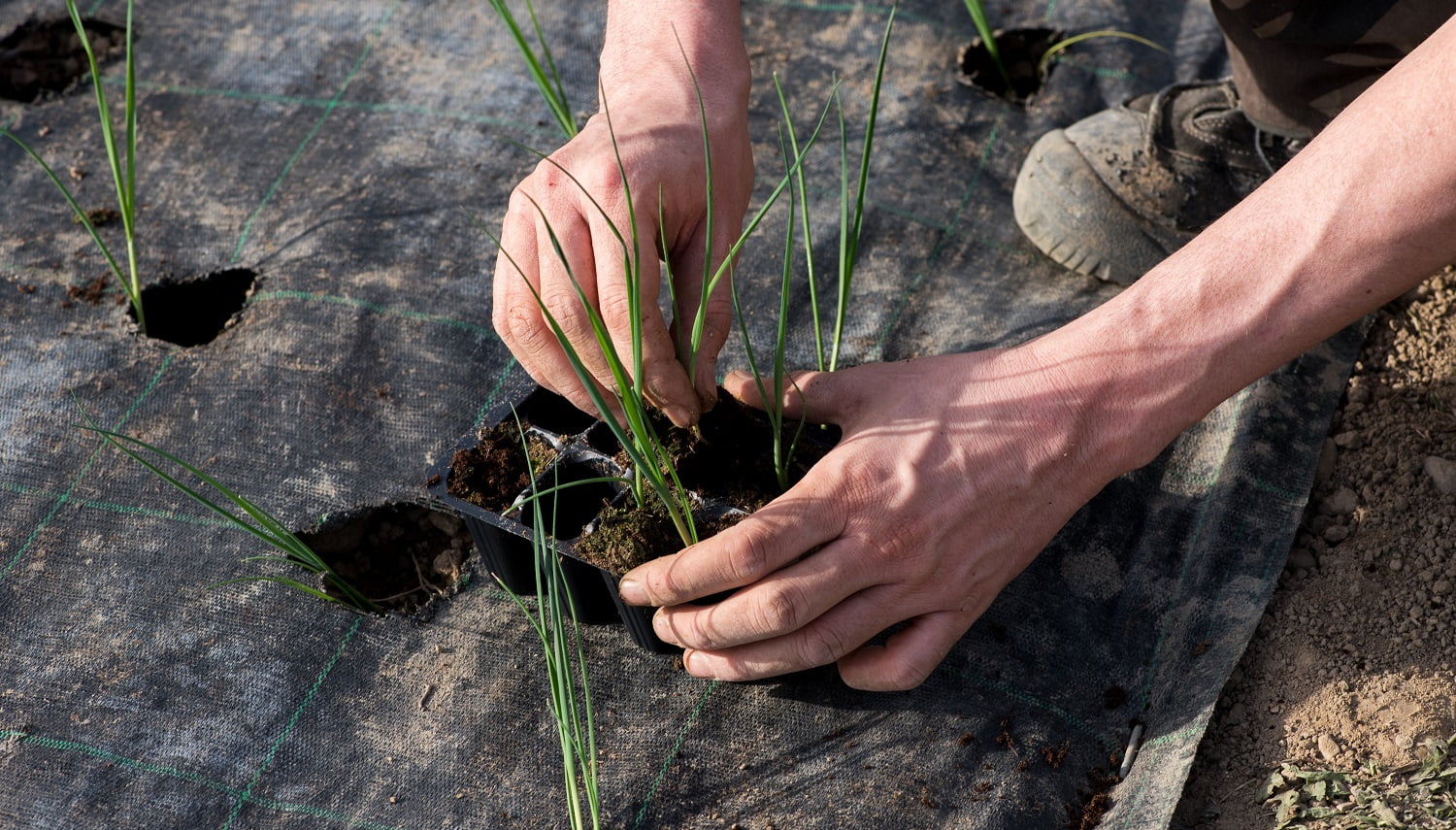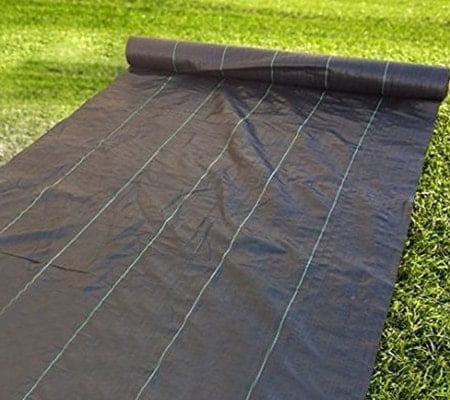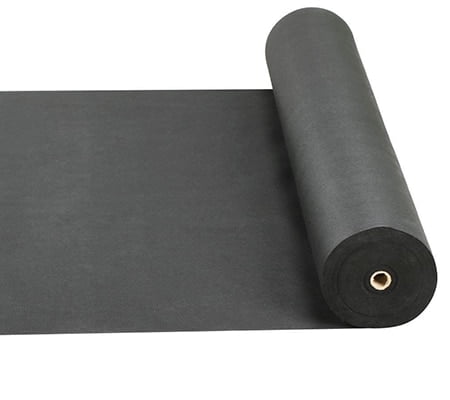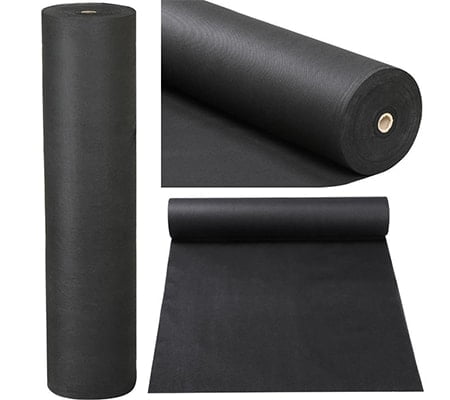Whether you're an avid gardener or have recently developed a green thumb, you must've dealt with annoying weeds. There is an effective way to fight them - landscape fabric.

While some gardeners prefer using chemical products and sprays to eliminate weeds, others might use weed picking tools for the job. However, if you're looking for a convenient and effective option to help you fight weeds, landscape fabric is a good choice.
The best thing about using this weed control method is that it is cost-effective and easy to install. Moreover, the fabric is breathable, allowing your beautiful garden to grow while effectively discouraging weed growth.
With several options of landscape fabric in the market, gardeners can choose according to their requirements. Whether you want woven or non-woven fabric depends on how you wish to grow your garden.
Now, let us tell you all about installing this effective weed barrier.
How To Install Landscape Fabric For Weed Control

What You Need
-
- Landscape fabric
- Garden hoe
- Steel rake
- Hammer
- Utility knife
- Landscape fabric staples
- Plants (optional)
- Mulch and other ground covers (also optional)

Step 1 - Start By Removing All Vegetation

The first thing you'll need to do is remove all forms of vegetation using a garden hoe or steel rake. Remove any plants, grass, and weeds along with their roots. Ensure that you dig deep enough to remove the roots - this is important, as you don't want to leave anything behind in the soil. Leaving any roots or small plants can cause them to grow over the landscape fabric.
You may also choose to kill the vegetation instead by using a broad-spectrum herbicide. Make sure to follow the manufacturer's instructions carefully when doing this. Also, keep yourself safe by wearing any protective gear you might need.
Step 2 - Clearing & Leveling The Soil

The next step is to clear the soil of any remaining roots, dead leaves, and debris. Use the steel garden rake (bow rake) to remove twigs, leaves, roots, stones, debris, and sharp objects from the soil. Throw away the collected rubbish material and level the soil using the rake.
Step 3 - Carefully Place The Landscape Fabric

Now comes one of the most important steps - cutting the landscape fabric to size. Lay down the landscape fabric parallel to the leveled soil and measure it carefully. Try and be as accurate as possible when doing this. Ensure that you cut enough landscape fabric to cover the area you have just leveled.
Use the utility knife to cut large pieces out, according to your measurements. It is practical to cut out slightly more fabric than your precise measurements, as you can always trim it later. However, cutting it too close to the measurements and then having less material to work with can be an issue.
You might require more than one row of landscape fabric. In this case, we suggest that you overlap the fabric by at least 6 inches (although the recommended overlapping is 3 inches).
Most landscape fabrics have two sides - one shiny and one dull. Ensure that you lay out the fabric on the soil with the right side up. Weigh down the fabric using stones or any other heavy object to get a precise measurement.
Step 4 - Securing The Landscape Fabric With Staples

Once you are satisfied with the measurements and layout, secure the landscape fabric using staples and a hammer. Drive each staple down into the ground about 10 feet apart, doing so along the edges and seams. Once this is complete, you can trim the fabric as needed for more accuracy.
Step 5 - Use Plants Through The Landscape Fabric (Optional)

Laying just the landscape fabric in your garden can look odd and out of place. This piece of fabric, though practical, can ruin the aesthetics of your garden.
To avoid that, you can choose to pot beautiful plants along the surface of the fabric. It helps to have an idea about where you want to plant them, what kind of plants to use, and how many you want. However, keep in mind - the fewer holes you make in the fabric, the better.
Taking the utility knife, make small, X-shaped incisions in the fabric. Ensure that the holes are not too large - just big enough to fit the root ball of the plant.
Have a tub or bucket beside you when you dig the soil, dumping it into the tub rather than on the surrounding fabric. Carefully place the plant in the hole, pouring soil around the root ball. Tamp the soil, remove any excess air, and lay the flaps around the plant's base snugly.
Step 6 - Add Mulch [Optional]

Simply scattering potted plants around the landscape fabric might look out of place. To cover the fabric and bring together the aesthetics of the garden, add mulch (or any other ground cover).
Make sure to add just about 2 inches of cover, and not more. You can also opt for natural mulch such as pine needles, wood chips, stone, rubble, etc. Spread it evenly, smoothing out the mulch with the rake. Do this carefully, so you don't puncture or tear the landscape fabric.
Things To Consider Before Buying Landscape Fabric
As with any product in the market, there are various types of landscape fabrics to choose from. Depending on your requirements, you can choose from woven and non-woven fabrics. Moreover, the appropriate material for an annual garden would be vastly different from what is appropriate for a desertscape or flower bed.
There are a few essential things you must consider before purchasing the right landscape fabric. From material to thickness, durability, and even cost, here are some factors you need to consider:
-
Woven Landscape Fabric

Woven landscape fabric or perforated fabric is made from natural materials like paper, burlap, or linen. They can also be made of manmade materials like polyester. These fabrics are made while keeping the 'movement of water' in mind. They are poros and breathable, allowing water to penetrate easily through them.
Woven fabrics are ideal for vegetable gardens or any soil which grows vegetation. The breathable material allows water to penetrate and soak the soil, thus encouraging plant growth.
This fabric also locks in the moisture from the soil, discouraging it from evaporating. It keeps the soil rich and moist, allowing the healthy growth of plants, vegetables, and grass. This makes woven fabric ideal for flower and vegetable beds growing in dry, arid climates.
-
Non-Woven Landscape Fabric

As opposed to woven fabrics, these landscape fabrics are designed to suffocate all kinds of growth and vegetables. Although they allow little breathability, it is not enough to encourage any sort of growth.
Non-woven landscape fabrics are typically made of polypropylene or polyester. It is mostly non-porous and doesn't allow the movement of water. It effectively eliminates the growth of weeds, but along with it, it also harms shrubs, plants, and the root system of trees.
This fabric is ideally used for stabilizing the soil behind paver patios, crushed stone walkways, or retaining walls.
-
UV Damage

You will also find various types of landscape fabrics that offer UV protection. Of course, there is an added cost to this.
Suppose you don't want to spend the extra money on 'UV protection,' good news! It is relatively straightforward to create your own DIY 'UV protection barrier.' Using 3 to 4 inches of mulch and other ground cover material will protect the landscape fabrics effectively.
-
Thickness Of The Material

Whether you opt for woven fabric or non-woven, there are varying levels of thickness offered by different manufacturers. Depending on how you plan on using the fabric, consider the thickness of the material before purchasing.
Although thicker landscape materials might cost more initially, it is also more durable, stable, and long-lasting. The thinner landscape fabrics are more affordable but are prone to tearing.
Consider the amount of foot traffic the fabric may eventually receive. If you plan on installing the fabric in an area where there will be constant walking, it is safer to opt for a thicker fabric.
How To Maintain Landscape Fabric
Landscape fabric is an effective and affordable method to control the growth of weed and stabilize the soil. Although it works perfectly fine on its own, most gardeners often opt for a ground covering, like using mulch, stones, or plants. This is done only for aesthetic and decorative purposes.
The fabric is breathable; however, it discourages weed seeds from germinating in the soil. Moreover, it ensures that any weeds that do happen to germinate do not push their way out (from the fabric) and ruin your garden. Many of these fabrics also prevent ants, insects, and other pests from destroying vegetation.
Here are a few tips that will help you maintain your landscape fabric.
-
Remove and Reorganize Mulch
If you decide to lay mulch over the fabric, you should be prepared to maintain it. The organic mulch will inevitably break down into the soil below. This supports the germination of grass and weed seeds. To prevent this from occurring, you need to replace and remove organic mulch periodically.
It helps to keenly observe the organic mulch, looking for signs of choked debris and soil. When you notice this, remove the mulch immediately and replace it with new organic material.
-
Clean & Maintain The Fabric
Conversely, if you decide not to cover the fabric with any material, there is a different kind of maintenance in order.
Soil, dust, dirt, and debris will inevitably fall onto the landscape fabric. Over time, it will get dirty. Moreover, if there is rain or snow, the fabric may face some damage. In these cases, it is imperative to clean the surface of the landscape fabric regularly.
Any soil or dust that blows over the fabric can support the germination of weed seeds. To prevent this, you need to clean the surface by dusting or sweeping the debris away. It goes without saying that you need to be careful not to tear or damage the fabric material.
-
Cleaning Stone Ground Covers
You may also opt for stone or rubble ground covers. While these instantly improve the aesthetics of the garden area, they also require periodic cleaning and maintenance.
When it comes to stone ground covers, raking them every once in a while is an excellent way to keep them clean. Hose them down with a garden hose every few weeks. You can always choose to replace the stone or rubble and lay completely new ones, adding a unique element to your garden.
-
Maintaining The Plants
Finally, if you decide to place plants intermittently (making holes in the landscape fabric and planting them), this is what you need to do.
The plants require water, sunlight, and food to thrive. Generally, people plant beautiful flowers and plants in the soil under the fabric for aesthetics. In order to maintain the aesthetics, you need to tend to the plants as you normally would.
It is important to keep a close eye on the plants, ensuring that they get enough water and food. Trimming and pruning will keep the plants looking beautiful, fresh, and vibrant.
Benefits Of Using Landscape Fabric
-
Weed Control
The primary reason to use landscape fabric is for weed control. As you might already know, weed growth is detrimental to the health of your plants. Weeds are capable of stealing nutrients from other plants. This causes your beautiful vegetation to become stunted and hungry for nutrients.
Installing landscape fabric ensures that small plants can thrive without weeds taking away their nutrition. Once these smaller plants grow large, their thick foliage does not allow sunlight to penetrate down to the soil, which the weeds require to grow.
It also helps your plants to bear more fruits, flowers, and vegetables, as the weeds do not eat away at their nutrients.
-
Erosion Control
Landscape fabric can do much more than control weed. It also controls the erosion of soil due to rain, snow, overwatering, or wind. The soil remains protected under the covering of the fabric. However, since the fabric is breathable, the plants and soil do not suffer underneath, receiving adequate amounts of water, sunlight, and food.
In places that receive large amounts of rainfall, soil erosion is extremely common. A lot of vital nutrients are also lost this way. Furthermore, soil erosion can damage your property. Laying landscape fabric under a layer of mulch can prevent this from occurring.
-
Environment-Friendly
If you want to maintain a beautiful garden, getting rid of weeds should be topping your priority list. Well, there are several ways to get rid of weeds. Applying chemical weed killers is one way. You can also manually pick out the weeds using various tools available in the market.
The problem with applying chemical weed killers is that you not only effectively kill the weeds but also harm the plants and soil. Moreover, the stronger a chemical weed killer is, the more it will damage its surroundings. Most of these weed killers are potent, toxic, and not environmentally friendly.
Opting for manual weed removers is an option; however, this can be laborious and time-consuming. Moreover, it does not eliminate weeds from growing back - only removes the ones which have already grown out.
Landscape fabric is the ideal solution to this problem. It is cost-effective, environmentally friendly, and lasts for months or even years.
-
Keeps Mulch In Place
The landscape fabric is an effective way of keeping mulch and other organic covering material from sinking into the soil. If you want to decorate your flower garden with stones, pebbles, or rubble, laying them on landscape fabric will keep them in place.
Furthermore, cleaning the mulch, stones, and rocks is much easier if the fabric is below it. It allows you to hose down the stones without allowing the dirt and dust to sink into the soil.
-
Helps The Soil Retain Moisture
If you live in a dry, arid climate, then dry soil can be a big problem. This kind of soil doesn't support the growth of various types of plants, flowers, and fruits. Extreme heat can also cause moisture from the soil to evaporate.
Landscape fabric is an easy and effective way to prevent that. Although the fabric is breathable and porous, it does not allow moisture to evaporate from the soil. This retained moisture keeps the soil moist, fertile and encourages healthy plant growth.
-
Easy To Install
As you might have noticed in our guide above, installing landscape fabric is relatively straightforward. Once you get the measurements correctly, all you need to do is cut, trim, and install the fabric over the soil. Of course, you can always get professional help for the same.

Final Words
Now that you know how to install landscape fabric, do you think you will get it for your garden?
Once you learn to install and maintain it (as we have illustrated in our guide above), landscape fabric can be a blessing in disguise. It is one of the most affordable, convenient, and long-term solutions you can opt for. Since it is environment-friendly, you don't need to worry about affecting the soil or plants around your garden.
With that, we have finally reached the end of our guide. Wish you good luck for installing landscape fabric in your garden!
Until next time!
Related Articles
The 5 Best Lawn Mowers for St Augustine Grass Right Now
Where to Find Good St. Augustine Grass Seed & How to Grow It
7 Best Shoes for Cutting Grass Comfortably | Buyer’s Guide
11 Best Mosquito Fogger Insecticide
9 Best Fertilizers for Petunias Right Now
9 Best Fertilizers for Hydrangeas
11 Best Fertilizers for Lilacs
13 Best Potting Mix For Orchids
